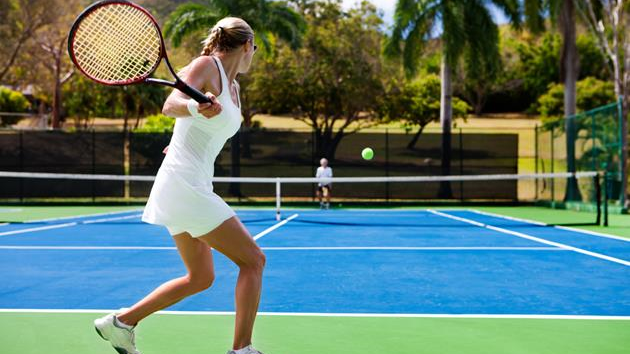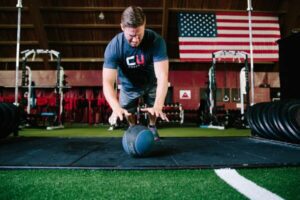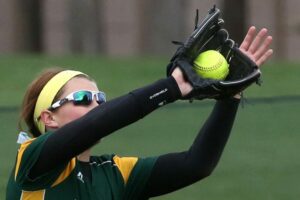Transitioning from Junior to a Professional
The transition from being a top Junior player to a Professional player involves several factors — some physical, some mental. Of course, physical size becomes an issue, as does fitness. However, I believe there are several “mental” transitions that need to be made in order to switch your mindset and abilities to the next level. Coaches and parents need to be on the lookout for these potential challenges.
The sooner you can break and re-mold your game with these ideals, the better.
Watching a slow-moving ball is a different skill from watching a fast-moving ball
If you have ever watched a pair of 8 year-olds exchange groundstrokes, you know that it is not much of a challenge for them to watch the ball. The ball is looping towards them and it doesn’t matter what they do with their heads, necks, or eyes as they will probably not lose track of it. As they progress, opponents will begin to hit the ball flatter and faster and they will have to develop techniques for watching a harder-hit object.
Some of them will make this transition effortlessly as they developed good habits early on, possibly by chance. However, some of the Juniors will have developed bad ball-watching habits, which no one will have noticed. As their opponents get bigger and hit harder, their game will suffer given that they’ll be forced to play catch-up on-the-fly. If your older Junior cannot deal with the pace or depth of a returned hit, this may be their problem.
The game of tennis requires that you hit the ball to a desired location
Somewhere between the time your opponent hits the ball and the time when you hit it back, you must try to make some crucial decisions in an awfully short amount of time. Exactly what shot am I hitting back? Juniors who make that decision, late during the flight of the ball, can get away with it when they are young and the game is slow and simple. As soon as the game gets faster and more complicated, unfortunately, this slow decision-making will become a problem.
One reason why is this: If you’re trying to hit a 70+ MPH groundstroke, the perceptual challenge is that, when watching the ball, it becomes very difficult to judge at the end of the flight. No one loses track of the ball while it is on the other side of the court.
This is where the perceptual challenge is highest. You do not want to be figuring out what shot to hit back as you’re swinging — that’s a recipe for disaster. Players who decide earlier can get into better positions, prepare better, and see the ball better as they meet it. A Junior must be encouraged to decide on his choice of return shot early in the flight or their growth will stagnate.
If the older Junior seems to be hitting shots with little rhyme or reason, and the accuracy is poor, this could be their new issue. When the ball is getting back sooner, the decision-making process must be made faster — it truly is that simple.
A young Junior player has a greater percentage of their eventual speed than of their eventual power
Frequently, 10 year-old match will go on for hours because no one has the power to hit a winner from the baseline and few athletes that age come to the net as they just get lobbed. At the younger ages, most players can run down almost every shot and get into very good position.
Ultimately, this means that the player can almost always set up and meet the ball at their favorite impact point, at their favorite height — maybe knee, thigh, or hip-high. However, as pace and power increases, a player will be forced to hit more balls at various heights and points in the ball’s flight. The pace of the ball will simply not allow them to get to that perfect spot all the time.
Older Juniors must learn to develop a proactive mindset as opposed to reactive thinking
Many Juniors don’t know how to create situations, they just wait for them to develop. For example, if your opponent comes to the net, most Juniors would target the next shot because the situation demands it. That is playing tennis reactively. But, if you get a ball in the center of the court and you just hit it back without a particular idea of what you should do to create a problem for your opponent, you have not been playing proactively.
These players see angles, spins, and depth as weapons. If you’re watching a Junior match and both players are continuously banging backhand crosscourt strokes at each other — a very common occurrence — it’s a safe bet that they’re both reactive players waiting for an opening instead of trying to create one. When you see a player who uses variety in pace, spin, arc, depth, like Roger Federer would, then they are being proactive.
Huddle Up
A reactive mindset is common in teenagers, just think about it. Young athletes are aren’t typically allowed to make big decisions in their lives, like even when to go to bed or what to have for dinner. So when they get to the tennis court, they tend to wait for things to just happen. Adults are the ones that are supposed to make things happen — but that, of course, is being proactive.
If you’re the coach or parent of a rising Junior, make sure your player is developing psychologically as well as physically. If you find yourself wondering what’s gone wrong his their progression as an athlete, check to see if they have made the necessary mental transitions.
Some of these transitions will not come naturally to many players, but, if discovered, the skill can be taught. Only then will the player be able to move up to the next level, and save everyone from great frustration.
How useful was this post?
Click on a star to rate it!
Average rating 0 / 5. Vote count: 0
No votes so far! Be the first to rate this post.



